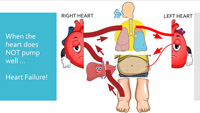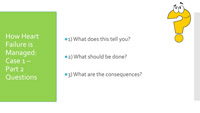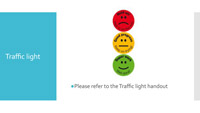Development and Piloting of a Community-Partnered Heart Failure Training Course for Home Health Care Workers
 Examples of content delivered during heart failure (HF) training course for home healthcare workers (HHWs). Figure legend (clockwise top left to right): sample case on interpreting vital signs (blood pressure and heart rate), grocery shopping case and identifying foods high in salt, traffic light tool used to help HHWs triage HF patients’ symptoms as stable, in need of monitoring, and emergencies and the need to call for help.
Examples of content delivered during heart failure (HF) training course for home healthcare workers (HHWs). Figure legend (clockwise top left to right): sample case on interpreting vital signs (blood pressure and heart rate), grocery shopping case and identifying foods high in salt, traffic light tool used to help HHWs triage HF patients’ symptoms as stable, in need of monitoring, and emergencies and the need to call for help.
Abstract
Background: Despite their unique contributions to heart failure (HF) care, home healthcare workers (HHWs) have unmet educational needs and many lack HF caregiving self-efficacy. To address this, we used a community-partnered approach to develop and pilot a HF training course for HHWs.
Methods: We partnered with the Training and Employment Fund, a benefit fund of the largest healthcare union in the United States, to develop a 2-hour virtual HF training course that met HHWs’ job-specific needs. English and Spanish-speaking HHWs interested in HF training, with access to Zoom, were eligible. We used a mixed methods design with pre/post surveys and semi-structured interviews to evaluate the course: (a) feasibility, (b) acceptability, and (c) effectiveness (change in knowledge [Dutch Heart Failure Knowledge Scale range 0−15] and caregiving self-efficacy [HF Caregiver Self-efficacy Scale range 0−100]).
Results: Of the 210 HHWs approached, 100 were eligible and agreed, and 70 enrolled. Of them, 53 (employed by 15 different home care agencies) participated. Post-training data showed significant improvements (pre-training mean [SD] versus post-training mean [SD]; P value) in HF knowledge (11.21 [1.90] versus 12.21 [1.85]; P=0.0000) and HF caregiving self-efficacy (75.21 [16.57] versus 82.29 [16.49]; P=0.0017); the greatest gains occurred among those with the lowest pre-training scores. Participants found the course engaging, technically feasible, and highly relevant to their scope of care.
Conclusions: We developed and piloted the first HF training course for HHWs, which was feasible, acceptable, and improved their HF knowledge and caregiving self-efficacy. Our findings warrant scalability to the workforce at large with a train-the-trainer model.




